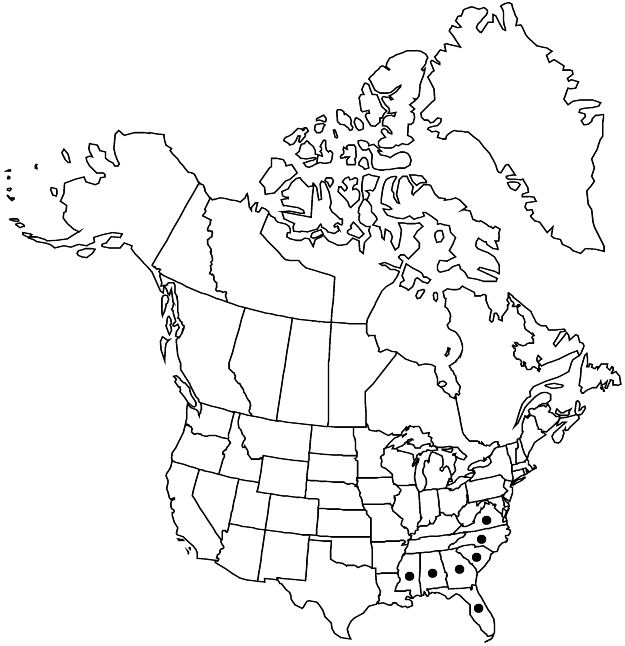Crataegus munda
Biltmore Bot. Stud. 1: 38. 1901.
Shrubs, stiff, compact, 5–20 dm, branches not weeping except in larger specimens. Stems: twigs: new growth green, densely appressed-pubescent, 1-year old purple brown-gray, slender; thorns on twigs numerous, ± straight, 2-years old purple-brown, slender, 1–3 cm. Leaves deciduous; stipules approximately obtriangular, thin; petiole length 0–28% blade, winged distally, pubescent only young, glandular; blade dark green young, narrowly obovate to cuneate or oblanceolate, 0.8–1.8 cm, thin to subchartaceous, base narrowly cuneate, lobes 0 or 3 per side distally, obscure, margins serrulate-crenate (distal 1/2), teeth glandular, veins 1 or 2 per side (exiting beyond widest part of leaf), apex usually obtuse, rarely acute, shiny mature, surfaces sparsely pubescent, abaxial ± densely pubescent near vein-axils. Inflorescences 1-flowered or 2 (or 3) -flowered; branches ± sparsely appressed-pubescent; bracteoles linear, margins sessile-glandular. Flowers 12–15 mm diam.; hypanthium pubescent; sepals triangular, margins glandular, abaxially pubescent; anthers ivory, rarely light purple; styles 3–5. Pomes red, suborbicular, 7–8 mm diam., glabrate; sepal remnants appressed; pyrenes 3–5.2n = 68.
Phenology: Flowering Mar–Apr; fruiting Jul–Aug.
Habitat: Sandy soil, open brush or among pines
Elevation: 0–200 m
Distribution

Ala., Fla., Ga., Miss., N.C., S.C., Va.
Discussion
Crataegus munda is one of the most widespread species in the series; it occurs from central Florida and southeastern Alabama to North Carolina with scarce outliers in Mississippi (Forest and Jones counties) and Virginia (Nansemond County).
Crataegus munda, like C. lepida, has a stiff, compact habit and usually lacks the weeping branches typical of the series; both are among the few species of hawthorn that regularly flower at under 1 m tall. Herbarium specimens of C. munda somewhat resemble C. lacrimata, but have shorter petioles, hairy young pedicels, and are more likely to have acute leaves with more pronounced marginal teeth. Some similarities may also exist to narrower-leaved forms of C. crocea, which has more pendant leaves with at most denticulate margins, usually much longer petioles, and nearly tomentose inflorescences and hypanthia.
A similar form, perhaps Crataegus geniculata Ashe, with usually larger, more sharply toothed leaves, 3 or 4 veins per side, larger flowers with less hairy pedicels, and subpyriform fruit, has been found in northeastern Georgia.
Selected References
None.
Lower Taxa
"thin" is not a number."winged" is not a number."thin" is not a number."adnate" is not a number."dm" is not declared as a valid unit of measurement for this property.